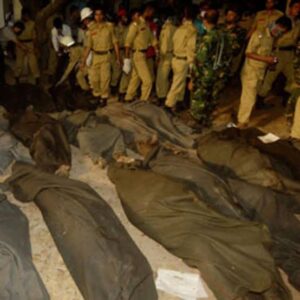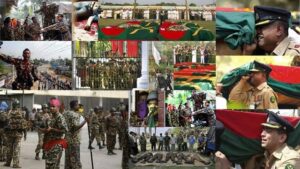Bangladesh BDR Mutiny and Pilkhana Massacre The BDR Mutiny also known as the Pilkhana Massacre was a grave incident that took place on February 25 and 26 2009 at the headquarters of the then Bangladesh Rifles (BDR) in Pilkhana, Dhaka. It was an armed rebellion where some BDR soldiers illegally took up arms and attacked their senior officers and their families.
History Beginning of the Incident: On the morning of February 25.during a durbar (assembly) mutinous soldiers seized the armory and opened fire. The first to be killed was Dhaka Sector Commander Colonel Mujibul Haque. Subsequently Major General Shakil Ahmed the then Director General of BDR along with many other officers and their families were targeted.
Casualties: In this massacre a total of 57 army officers 17 civilians and some women and children were killed. The mutiny spread to 12 cities on the second day.
Resolution: After negotiations with the government, the mutineers surrendered their weapons and released hostages on the night of February 26.
Consequences: Following the incident the name of BDR was changed to Border Guard Bangladesh (BGB). In 2013 a court sentenced 152 individuals to death and 161 to life imprisonment. Subsequent investigations and appeals are ong.
Involved Individuals:
Major General Shakil Ahmed: The then Director General of BDR who was killed during the massacre.
Mutinous Soldiers: BDR jawans of various ranks led by Subedar Gofuran Mallik whose demands included better pay and promotions.
Political and External Involvement: Allegations were made against Awami League leaders such as Sheikh Hasina Sheikh Fazle Noor Taposh and Sheikh Selim but these were not directly proven in investigations. Some opinions also suggested a conspiracy involving India though this remains unproven.
Role of the Army: General Moeen Uddin Ahmed (then Army Chief) and the 46th Independent Infantry Brigade intervened to control the situation though immediate effectiveness was limited.
Current Situation: After the fall of Sheikh Hasina’s government in 2024 a new investigation commission has been formed to uncover the true facts behind the incident. However 16 years later challenges remain in collecting evidence and delivering justice.
Causes of the BDR Mutiny (Pilkhana Massacre): The causes of the BDR mutiny have been analyzed from various perspectives though not all are unanimously agreed upon. The main reasons are as follows.
Professional Discontent: BDR soldiers had long-standing grievances regarding inadequate salaries, allowances, and lack of promotions. They alleged discrimination and neglect by senior officers.
Administrative Crisis: The appointment of army officers in BDR leadership roles created resentment among the soldiers, leading to strained relations.
Political Influence: Some analysts believe that political pressure and dissatisfaction within parts of the BDR following the Awami League’s rise to power may have incited the mutiny though this is not proven.
Economic and External Support: Some reports claimed that certain mutiny leaders received economic support from external forces India or others but this has not been substantiated by investigations.
Spontaneous Outburst: The mutiny is believed to have been unplanned starting as a sudden event that escalated into a reckless massacre.
These causes have surfaced at various stages of investigations but the ultimate truth remains unclear. Ongoing investigations may uncover further details.
Political Impact of the BDR Mutiny: The BDR mutiny had profound and long-lasting political impacts affecting Bangladesh.s political and security systems. The main impacts are as follows. Government Authority and Negotiations: Occurring in the first year of Sheikh Hasina.s Awami League government the incident raised questions about the government’s security management. Weaknesses during negotiations with the mutineers became a source of criticism.
Allegations of Political Connections: Some political parties and analysts alleged connections between the mutineers and the Awami League sparking intense political debates though these claims remain unproven.
Formation of BGB: The restructuring of BDR into Border Guard Bangladesh (BGB) was an attempt to strengthen control under the army and government seen as a crucial step for political stability.Military and Political Relations: The incident created a degree of distrust between the army and the government influencing subsequent military. political dynamics.
2024 Political Fall: The impact of the 2009 mutiny resurfaced during the fall of Sheikh Hasina.s government in 2024 with demands for re-evaluation and new investigations.This incident created skepticism and caution in Bangladesh’s political system which continues to have an impact from time to time.
Latest Update:
Following the fall of former Prime Minister Sheikh Hasina, a new investigation team has been formed and the public is awaiting proper justice for this incident.
















